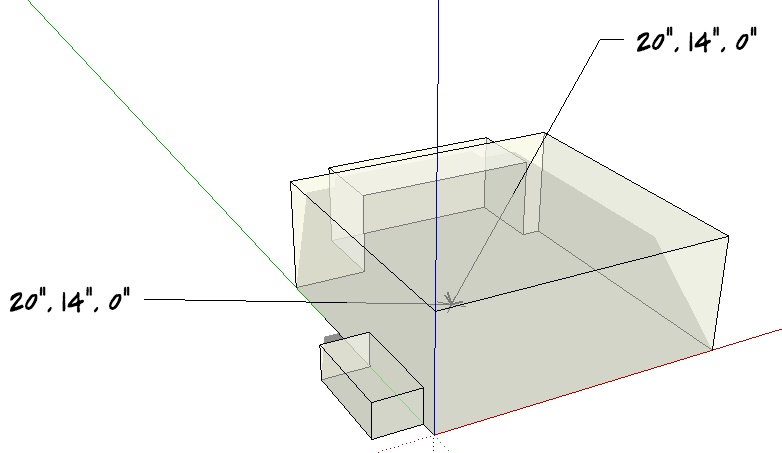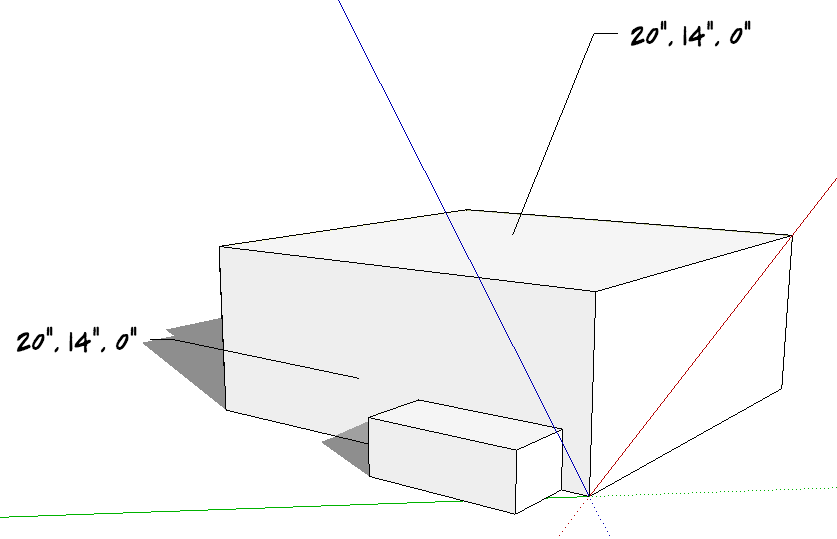Coordinates
-
Would it help to move the origin to a location more relevant to your model, so that the resulting coords likewise had more meaning?
-
Changing the location of the axes and their origin doesn't change the location of 0,0,0.
I moved the global axes to the location shown in this screen shot. The leader text to the left was inserted after moving those axes.

-
I see. That's a big surprise to me and doesn't seem right. Origin should be 0,0,0, as the book, some book, is written. Ain't it, not?
0,0,0 originates at the origin, why doesn't it stick with the origin? 'They'll' say the origin originates at 0,0,0, but then you moved it, but you did not move the location of 0,0,0.
-
The real origin and the ground plane, for that matter are fixed in SketchUp. When you open a new SketchUp session the axes are located such that they cross at the origin (0,0,0). Moving the axes doesn't change the location of the origin nor the ground plane.
Notice in this screen shot of the same model, I not only moved the crossing of the axes, I tilted them. But the shadows still show on the ground plane. Standard views would still be the same as well.

-
Thanks. This seems inflexible and counter-productive. Perhaps someone will enlighten me.
-
I don't know. In my 8 years of modeling in SketchUp I've never found any need to move the global axes so it's never been a problem for me. Granted there may be cases where it would be useful. I just haven't found any situations where it is for me.
On the other hand, I've seen a number of models that were screwed up because someone did move the axes but didn't realize it. They couldn't figure out how to correct things because they didn't really know what the problem was.
It seems reasonable to me to have a permanently fixed point of reference in the model space .
-
Perhaps, given that the whole model could be moved relative to the origin rather than the other way around. Seems much more complicated, though, and potentially even more error prone.
-
I don't know why moving the model would be more prone to errors. I tend to think of the model space as real space and the model or parts of the model as real entities. If I had a table that I wasn't to be 6 feet to the right and turned 90 degrees, I wouldn't try to move the house or the earth around the table. I'd just move the table. Same thing in SketchUp.
-
If my models were tables, I might agree. But still, the origin is an idea not an absolute, not the earth. If it were a real earth fix that would be cool. But it is a construct of SU and so I think should be configurable. I appreciate someone wanting to protect me from myself so long as they don't limit me to do so. I am in most ways free to screw up, or make better, my world. As it turns out, my models are overly wrought things with sometimes hundreds of layers, terrain and construction alternates. (Surely they could be more manageable than they are but I think that is not what we are talking about, primarily.) And moving the whole quivering mass to another spot so as not to have to alternatively move a conceptual point seems not right, nor the easiest way. But I do understand your point. As it turns out my origins have not proven to be problematic for me, but that neither is the point.
-
Perhaps I'm missing the intent of the original question, but, is the question about finding the coordinates of an existing object relative to the global or world ('all the world's a stage...') coordinate system?
If it is, then why not use the query tool?
Advertisement







